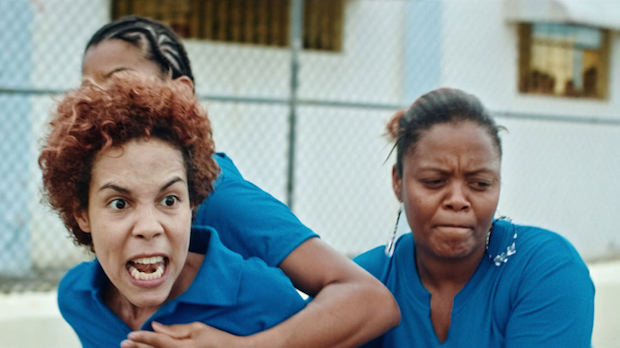 Back to selection
Back to selection
Writer/Directing/Editor José María Cabral on Sundance Prison Drama Woodpeckers
 Woodpeckers
Woodpeckers Dominican writer/director José María Cabral has made several feature films at the age of just 28. His latest, Woodpeckers (Carpinteros), tells a love story inside the Najayo Prison in the Dominican Republic. As he’s done on most of his features to date, Cabral served as the editor on Woodpeckers. Below, Cabral discusses the challenges of editing this film, which relies heavily on a form of prison sign language (or wood-pecking) for communication. Woodpeckers premiered in competition at the 2017 Sundance Film Festival.
Filmmaker: How and why did you wind up being the editor of your film? What were the factors and attributes that led to your being hired for this job?
Cabral: Well, first things first: Budget. When I started filming the movie, as the director and screenwriter, I did not have budget for post production, so once I finished the shoot I started cutting. In the process I felt I was still directing the movie in the editing lab; I used my crew members and friends as a resource for comments and opinions to get the best out of it. Fortunately I found the money for post production right at the end.
Filmmaker: In terms of advancing your film from its earliest assembly to your final cut, what were your goals as an editor? What elements of the film did you want to enhance, or preserve, or tease out or totally reshape?
Cabral: My main concern was pacing and rhythm; this is what some of my other movies lacked. So I had this goal of having the right pacing it needed to understand the universe of the prison and also penetrate into the journey of my characters, especially Julian.
Filmmaker: How did you achieve these goals? What types of editing techniques, or processes, or feedback screenings allowed this work to occur?
Cabral: Screenings were very important, I’ve learned so much out of them. I do different steps of screenings, first to editors, then to directors, film crew, then I reach out to some critics I know, and then I get friends and random people to comment too. The last screening is for my mother — if she gets it, I know we’re good, haha!
Filmmaker: As an editor, how did you come up in the business, and what influences have affected your work?
Cabral: I have only edited my movies, basically because when I started filmmaking there was no other option than editing for yourself. Along the way I’ve felt this as part of my job as directing; I know directors like Alfonso Cuarón, Kurosawa, Robert Rodriguez, among others, who also edit their films. I just love every piece and bit of making movies, but I’m willing to explore and work with another editor.
Filmmaker: What editing system did you use, and why?
Cabral: Adobe Premiere Pro; it’s quick and very friendly. That’s all I need.
Filmmaker: What was the most difficult scene to cut and why? And how did you do it?
Cabral: The “carpinteros” one; all those scenes with sign language were pretty hard. First because I needed to learn the language in some way, constantly check if they were using the accurate translation and then looking for performance. It took time, but it was also fun.
Filmmaker: Finally, now that the process is over, what new meanings has the film taken on for you? What did you discover in the footage that you might not have seen initially, and how does your final understanding of the film differ from the understanding that you began with?
Cabral: Kind of difficult to answer, cause since I wrote the film in prison for about nine months, then shot it and after that edited it, the film went through a transformation, and so did I. Looking back is kind of blurry; the movie has shaped me in so many ways that my eyes can only see it as a whole. If I’d be only the editor, maybe it would’ve been different, but being involved in every process is different. What I can say is my final understanding was discovering something unique and beautiful even in the darkest and most dangerous places on earth.
